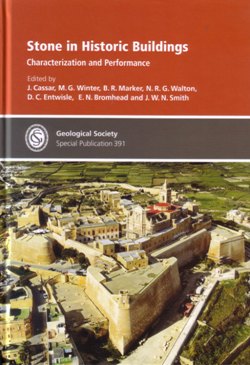 For millennia stone has been exploited for building, architectural use, decoration and ornamentation. Where did suitable stone occur? What were its geological characteristics and context? What were its technical and aesthetic properties? Were transport communications good? How costly was the stone? Did the stone have cultural significance in being emblematic of the district or region of its exploitation? Have problems of building conservation arisen because the original quarries fell out of use or disappeared and an acceptable replacement stone was hard to find? These are among the questions addressed in this Special Publication of the Geological Society, edited by a team led by J. Cassar of the University of Malta, a worthy successor to the Society’s previous Special Publications 205, 271, 331, 333 and 391 (see also the Geological society of America’s Special Paper 390).
For millennia stone has been exploited for building, architectural use, decoration and ornamentation. Where did suitable stone occur? What were its geological characteristics and context? What were its technical and aesthetic properties? Were transport communications good? How costly was the stone? Did the stone have cultural significance in being emblematic of the district or region of its exploitation? Have problems of building conservation arisen because the original quarries fell out of use or disappeared and an acceptable replacement stone was hard to find? These are among the questions addressed in this Special Publication of the Geological Society, edited by a team led by J. Cassar of the University of Malta, a worthy successor to the Society’s previous Special Publications 205, 271, 331, 333 and 391 (see also the Geological society of America’s Special Paper 390).
Three papers cover availability. Bristow reviews stone in Cornwall, and especially the granites. From West Sussex Cordiner records an extraordinary 52 lithologies to be found in the County’s180 late medieval to modern churches, noting a strong geographical control on their distribution. Turning to Tuscany, Fratini and Rescic review the complicated igneous, sedimentary and metamorphic rocks of this region, their use in historic buildings, and the subsequent problems of conservation.
The thrust of two technical papers, both by Calia and others, is on the characterization of stone from the standpoint of the Italian conservator: the porous calcarenite called pietra gentile in Puglia, and the calcarenite known as Lecce stone used in the Salento region.
Many buildings and settlements present problems of conservation and restoration. The restoration of buildings of Lede stone in Belgium (de Kock et al.) and of Reims Cathedral in northeast France (Turmel et al.) is proving difficult because the limestones originally used are no longer available. The buildings and monuments of Salamanca in central Spain – a UNESCO World Heritage Site – exploited a wide range of materials, not all of which are now available (Peirera and Cooper). André et al. explore the benefits and disadvantages of different pointing mortars used to conserve Romanesque churches in the French Massif Central.
The odd man out in this collection is the paper by Laycock and Wood describing laboratory experiments on the penetration of rain into masonry.
The production standard is high, except for most of the illustrations of the thin-sections, which are too small to be of real use. A map of Spain would have helped the reader unfamiliar with the whereabouts of Salamanca.
Reviewed by J.R.L. Allen
STONE IN HISTORIC BUILDINGS. CHARACTERIZATION AND PERFORMANCE: J. Cassar et al. (EDS). 2014. Published by: Geological Society, London, Special Publications. 391. 200 pp. ISBN 978-1-86239-376-9. List price:??? List price: £90.00; Fellows' price: £45.00; Other societies' price: £54.00